| 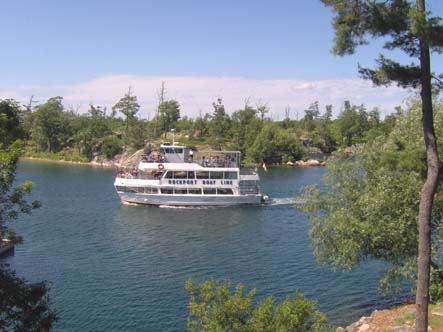
“The longest undefended border
in the world”
Across the over 3000-mile border that Canada
and the United States share from the Atlantic to the Pacific coasts,
there are a number of places where this dividing line actually serves
to link the peoples of these two countries in an especially close
and intimate way. Perhaps nowhere is this truer than along the majestic
St. Lawrence River in the fabled 1000 Islands region, where the
border and the river that defines it have played a major role in
the history of the two countries, and continue to shape their respective
destinies today.
The ebb and flow of the St. Lawrence as its
waters make their slow, stately journey from the Great Lakes basin
to the Atlantic Ocean has served as a marker for a number of key
episodes in Canadian-American relations, some involving conflict,
and others peaceful cooperation. This scenic and historically rich
area, a major tourist destination of eastern North America, is a
fascinating place to explore the many things that Canadians and
Americans share in common, as well as those that set them apart
as distinct peoples.
I have visited the St. Lawrence region on
the Canadian side of the border many times, often using our nearby
family summer home in Prince Edward County, just west of Kingston,
as a base for my travels. But aside from a few short forays across
the border to upstate New York on family trips as a child, I had
never passed any considerable time on that side of the line. For
this reason, I looked forward to spending a few days in the charming
town of Clayton New York, and exploring the adjoining vicinity as
the guest of the 1000 Islands International Tourism Council and
its marketing and communications director, Suzanne Bixby. On a beautiful
late June day I made the short drive from Toronto along the northern
shore of Lake Ontario, crossed the 1000 Islands International Bridge,
one of the many that span the St. Lawrence, and arrived in Clayton
by late afternoon. My 1000 Islands experience was about to begin.
Transborder awareness
The fact that an international council is responsible for
tourism in the 1000 Islands is typical of this region, where Canadians
and Americans are neighbours, who shuttle back and forth across
the border on a regular basis. They are also very knowledgeable
about each other’s countries, which is not always the case,
especially as far as some Americans are concerned, a point of contention
for Canadians.
On the way to my first dinner engagement, at Captain’s
Landing, a floating restaurant in nearby Alexandria Bay, I was surprised
to find that Suzanne had her car radio tuned to a familiar Canadian
news journal, “As it Happens.” She explained to me that
she is a frequent listener to this program, because she found its
in-depth treatment of current events to be much more informative
and objective than most of what was available on the major American
media outlets. She also told me that she and her husband, a reserve
officer in the U.S. Army at nearby Fort Drum, frequently visit the
Ontario city of Kingston to enjoy its restaurants and other cultural
facilities. As someone who is occasionally perturbed by many Americans’
lack of knowledge of or even interest in Canada, I was pleasantly
surprised and already felt right at home on the American side of
the river!
The mighty St. Lawrence runs through it
Captain’s Landing boasts that it is the only floating
restaurant in the 1000 Islands region, and it is well situated on
the main shipping channel of the St. Lawrence Seaway, directly across
from Boldt Castle, probably the most famous tourist site in the
area. As I dined on a delicious salmon filet, accompanied by a glass
of local white wine and a rich dessert appropriately known as “peanut
panic,” I enjoyed the view of the imposing stone front of
the castle. I was already anticipating my visit to this landmark
destination on a boat cruise of the islands the next day. It was
also pleasant to feel the gentle rocking of the floor as a passing
ship caused some small waves to move the floating restaurant.
After dinner I took a stroll along Clayton’s main
street that runs parallel to the river, admiring the many old houses,
stores, and other historic buildings. The stillness of the evening,
the slight scent of water in the clear air, and the golden glow
that the setting sun cast across the slowly moving waters of the
St. Lawrence conveyed a sense of peace and tranquility. The omnipresence
of the river was almost palpable, and I could appreciate the important
place it occupies in the lives of the people who live along its
banks. I was to spend two peaceful nights at the charming Wooden
Boat Inn, located just off the main business section of Clayton,
an easy walk from all the town’s restaurants, stores, and
other attractions.
A meandering border
Although this region is world-renowned as the “1000”
Islands, in actual fact there are 1864 of them scattered along an
approximately 80-mile stretch of the river from Lake Ontario to
the eastern border towns of Cornwall Ontario and Massena New York.
But by far the highest concentration of islands can be found in
the area that I was visiting, around the 1000 Islands International
Bridge separating Canada and the United States. The border goes
around each island in such a way that none of them are divided into
Canadian and American sectors.
This decision was made following the
War of 1812 under the terms of the Treaty of Ghent, which allocated
two-thirds of the islands to Canada and the other third to the United
States. However, the total land area of the islands each country
owns is approximately equal. Wolfe and Howe are the largest Canadian
islands, while Grindstone and Wellesley are the main American ones.
Tiny Tom Thumb Island, nothing more than a grassy dot in the water,
is the smallest island. Individual homes and cottages, ranging from
the modest to the palatial, have been built on many of the smaller
islands that are individually owned, in some cases by the same families
for many years.
A geological sight to behold
The 1000 Islands were formed after the last great ice age,
when mile-thick glaciers covered almost all of North America. As
this ice shield gradually melted, it dug away the topsoil and left
exposed the rocky outcroppings that formed the islands. The rocks
themselves date from the Precambrian era, over one billion years
ago, and are some of the oldest found on the planet. The pleasant
pink hue of the rocks, especially attractive at sunrise and sunset,
is the result of the rusting of the metals found in them.
The longest inland waterway in the world
Jacques Cartier, the French explorer, was the first European
to reach the St. Lawrence River in his first voyage of discovery
in 1534. Like many European explorers, Cartier was searching for
what he hoped would be the famous “Northwest Passage”
that would lead him to Asia.
Little did he know then, however, that this majestic river
would not lead him to the east, but was in fact the gateway into
North America and the Great Lakes. During normal winters, the water
of the St. Lawrence freezes solid in the 1000 Islands area, permitting
local residents to drive their cars and trucks across to the mainland.
At this point in the river’s course from the Great Lakes to
the Atlantic, it is 212 feet above sea level. From here to Montreal
there are seven locking systems that lower seagoing vessels down
to sea level. After the completion of the St. Lawrence Seaway in
1959, the entire St. Lawrence-Great Lakes region was open to seagoing
ships, making the ports of Toronto, Erie, Detroit and Chicago open
to them.
Away from the madding crowd
The 1000 Islands became a popular tourist destination during
the later part of the 19th century, after a number of prominent
Americans, including former Civil War hero and president Ulysses
S. Grant, were invited to the area to partake of its splendid fishing
possibilities. The resulting newspaper coverage raised the region’s
profile to the extent that wealthy Americans from New York City
and other nearby urban areas began to travel by rail to the 1000
Islands to spend peaceful summer vacations. A number of large, luxurious
hotels were built in towns like Clayton and Alexandria Bay, and
in addition many of the more affluent visitors began to purchase
their own islands and erect magnificent summer homes on them. The
region was popular because of its stunning scenery, pleasant summer
climate, fine fishing and boating, and proximity to major cities
on the eastern seaboard.
The next morning I strolled into town for a pleasant breakfast
at Bella’s, a small waterfront café with an outdoor
patio overlooking the river. From there I drove to the 1000 Islands
Welcome Centre, the region’s major tourist bureau, conveniently
located on the American side of the bridge. Its friendly and well-informed
staff can provide a wealth of information and ideas to the visitor
about the many attractions the 1000 Islands have on display. Among
the most popular of these are the boat cruises companies on both
sides of the border offer. Years ago I had taken one of these from
the Canadian town of Gananoque, but this time I was the guest of
the 100-per-cent American Uncle Sam Boat Tours, leaving from Alexandria
Bay. This company offers a number of cruises, from the one-hour
“Millionaire’s Row” tour to a romantic dinner
cruise with live entertainment
|
The
1000 Islands and the Ebb and Flow of Canadian-American Relations
by Peter Flaherty
Borders divide countries and peoples. But
sometimes they bring them together in transition zones where they
can learn more about each other and discover their many similarities
and differences.

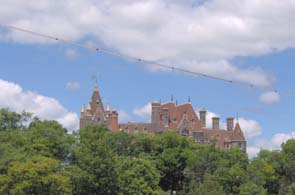
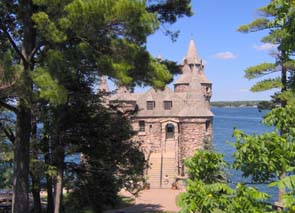
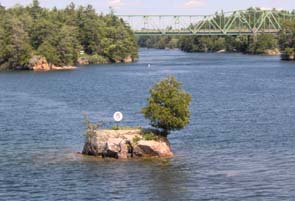
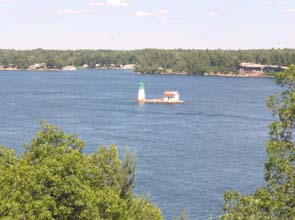



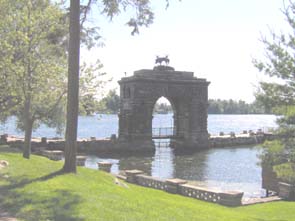
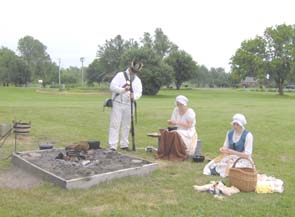
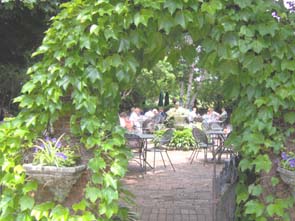

For more information on the 1000
Islands
The official
website of the 1000 Islands Convention and Visitors Bureau
Alexandria
Bay
The
Robert Moses 1000 Islands State Park
The
Wellesley Island State Park
Sacket's
Harbor
The
Sacket's Harbor battlefield site
Sacket's
Harbor Chamber of Commerce
Save
the River, an environmental organization dedicated to preserving the
St. Lawrence
The
Seaway Trail
The
New York State food and wine festival which is held annually in Clayton
Personal recommendations
The
Wooden Boat Inn
Uncle
Sam boat tours site
Boldt
Castle
The
Wellesley Hotel and Restaurant
T.I.
Adventures
The
river village of Clayton
The
Antique Boat Museum
Everything
you need to know, and more, about the famous salad dressing, part
of the 1000 Islands Inn site
Larry
Barone's art gallery in Sacket's Harbor
A
local winery in Alex Bay
Photographs by
Peter Flaherty |
|
I went aboard the “Alexandria Belle” shortly
after noon for the “Two Nations Tour.” This proved to
be an extremely interesting and informative trip that took me to
all of the major sites, including “Millionaire’s Row,”
the group of impressive summer homes dotting the islands in the
channel, Boldt Castle, and Wellesley Island, the largest in the
area. Wellesley is also the island where some of the most magnificent
turn-of-the-century gingerbread-style summer homes are located,
in an upscale enclave located in the middle of the 1000 Islands
State Park. Uncle Sam Boat Tours operates seven vessels that depart
from Alexandria Bay and Clayton. The most popular ships in the fleet
are the two 440-passenger triple deckers, with a paddle wheel attached
to the stern, Mississippi riverboat style! The Thomson family has
operated the company since its founding by Captain C.S. Thomson
in 1890.
A melancholic touch of the Waldorf
By far the most famous and popular stop on the tour is
Boldt Castle, an imposing, brooding, half-finished edifice that
dominates the channel on Heart Island. It takes its name from George
Boldt, a wealthy late 19th century entrepreneur and hotel operator
who intended it to be a birthday present for his wife, Louise.
Boldt had immigrated to the United States from Prussia
in 1864 at the age of 13 and his career is a classic “rags-to-riches”
story of pursuit of the American dream. His first job was in the
kitchen of a New York hotel. Through dint of hard work and considerable
drive and ambition, he became the manager of another hotel on the
Hudson River in just a few years. In 1876 he moved to Philadelphia,
where he eventually built and operated the Bellevue Stratford Hotel.
It was at this point in his life that he met and married Louise,
the daughter of William Kerher, a fellow German immigrant who had
helped him in his Philadelphia business ventures.
Back in New York a few years later, Boldt found himself
manager of the prestigious Waldorf Hotel, which was expanded to
become the Waldorf-Astoria, after John Jacob Astor, brother and
business partner of William Waldorf Astor, added a luxurious addition
to it. By this time Boldt was the highest salaried employee in the
world, earning over $1 million per year. His innovative management
techniques, including the introduction of room service and the invention
of the famous “Waldorf Salad” attracted the attention
of his employers and gained him considerable status and fame. Boldt
and his family spent many happy summers in the 1000 Islands before
launching the construction of his opulent dream home, an undertaking
that was sadly to result in tragedy.
Boldt Castle was emerging as a magnificent structure on
Heart Island in 1900 as Boldt personally supervised its construction.
No expense was spared as 300 skilled workers, including stonemasons,
carpenters, and artists laboured year-round to build a six-story,
120-room castle, that was to include tunnels, a powerhouse, Italian
gardens, a drawbridge, a dovecote, and an adjoining boat house.
Boldt wanted the castle to resemble the medieval and renaissance
chateaux and villas he had marvelled at during his visits to France
and Italy. It was to combine both classical and modern architectural
features, such as medieval towers and arches coupled with large
plate-glass windows and extensive, sweeping verandas. There was
to be an indoor swimming pool on the main floor, and a tower room
at the top, reached by an elevator. The floors and roofs were of
steel and concrete construction to prevent fire, always a threat
to homes built on the 1000 Islands. The granite walls were ornamented
with intricate decorations made of terra cotta. The entire island
was given over to what was to be a truly magnificent summer home,
one that Boldt hoped he and his family would enjoy for many years
to come. But most importantly, it was to stand as a perpetual reminder
of the great love he felt for his wife.
Unfortunately, it was not to be. In January 1904, Louise
Boldt died suddenly of pneumonia in New York at the age of only
42. Boldt was devastated by his wife’s death and immediately
dispatched a telegram to the workers engaged on the construction
of his dream home to halt all activity. After the departure of the
workers from the island, orders for the fine sculptures, Italian
mantle pieces, tapestries, and deluxe furniture that Boldt had ordered
for the castle were suddenly cancelled. The half-finished structure
was left abandoned, and even though Boldt and his family continued
to spend summers in the 1000 Islands, he never set foot on Heart
Island again.
From the time construction was halted in 1904 until the
1970s the half-finished castle deteriorated into a ruinous state
of disrepair, as tourists passed by it on island cruises, looking
on in sadness and amazement. But in 1977 the 1000 Islands Bridge
Authority took on an ambitious program of restoration of the building.
Today it is possible to stop and explore the beautiful grounds of
this melancholy place, and admire the sheer scope of the luxury
and ambition of Boldt’s dream castle.
The day I visited Heart Island was bright and sunny, and
it was almost possible at times to forget the pall of sadness that
frequently casts itself on the place. The castle itself is open
to the public and both the finished and uncompleted floors can be
toured. Besides the main building itself, there are many other points
of interest, including the impressive powerhouse, the Alster Tower,
the Dovecote, the Arch, and a stone-carved outdoor gazebo. All of
these adjoining buildings can easily be reached along the flower-banked
footpaths that connect them. Just across from the island is the
magnificent boathouse located on the tip of Wellesley Island, which
can be reached by a boat shuttle. Here Boldt kept his yacht and
a huge houseboat that can now be seen at the Antique Boat Museum
in Clayton. But many smaller antique wooden boats are on display
here, many of them originally belonging to the Boldt family. Since
it was the only building in the castle complex to be completed,
the boathouse is truly a fascinating structure, embodying all the
luxury, refinement, and ostentation of the “Gilded Age”
when wealthy American businessmen such s George Boldt spared no
expense to pursue their passions and their dreams.
Transborder rebels and international diplomacy
Another very different island that I visited on this tour
was Devil’s Island, deriving its strange name from a cavern
called the “Devil’s Island” located on it. Devil’s
Island’s historic claim to fame lies in the fact that it was
the hiding-place of a man named Bill Johnston, a native New Yorker
who participated in what is known as the “Patriot’s
War” in the United States, and the “Rebellion of 1837”
in Canada.
Although Britain and the United States had made peace following
the War of 1812, and the border dividing Upper Canada, as Ontario
was then known, and New York state had been agreed upon, there were
still many issues of potential conflict between the two countries.
Many Americans did not like the fact that Canada was still under
British colonial rule, and made common cause with Canadian radicals
who sought complete independence from Britain, or at least a greater
degree of local self-government. Under the banner “Canada
for Canadians,” Johnston and other New Yorkers joined the
“Hunters’ Lodges” and linked up with followers
of William Lyon Mackenzie, the radical newspaper editor and mayor
of Toronto to drive the British out.
Although British forces had checked Mackenzie’s abortive
revolt outside Toronto in December 1837, Johnston and other American
supporters were not about to stop the struggle to liberate Upper
Canada from colonial rule. In the spring of 1838 an attack was planned
against a British contingent based near Kingston. Unfortunately
for the rebels it never took place, since the after-effects of a
victory party hosted in advance of the fighting left most of them
unfit for combat the next day! But Johnston and a small group of
followers did attack and sink a British river boat, the Sir Robert
Peel, after robbing its passengers and putting them ashore nearby.
Since the American government was anxious to preserve good relations
with Britain and did not want to provoke an international incident,
it made common cause with British authorities to track down and
arrest Johnston and the other radicals. For a year he hid out on
Devil’s Island, where his daughter brought food and supplies
to him every day. After a year in hiding, Johnston emerged, turned
himself in, and received an official pardon. Later he obtained a
position as a lighthouse keeper in the 1000 Islands.
And on your salad?
Of course no visit to the 1000 Islands would be complete
without sampling what is certainly its best-known culinary creation
— the world-renowned “1000 Islands” salad dressing.
That night I dined at the 1000 Islands Inn, a charming
turn-of-the-century hotel-restaurant in Clayton dating from the
region’s golden age of tourism, when it was known as the Herald
Hotel. Here I enjoyed a delicious dinner of filet of fresh-caught
St. Lawrence walleye, accompanied again by a fine glass of local
white wine and a decadent dessert of peanut pie. And of course my
appetizer that evening was a delicious salad of tomatoes and fresh
green vegetables, accompanied by the famous 1000 Islands dressing.
The menu provides a detailed account of how this dressing, the only
one named after a specific geographical region of the United States,
came to be invented.
It seems that in the early years of the 20th century, a
local fishing guide named George Lalonde took fishermen on expeditions
in the area, and was renowned for the delicious fish dinners of
black bass, northern pike, or muskie he prepared for his guests.
On one of these fishing trips, the party included a woman named
May Irwin, who was accompanying her husband. Mrs. Irwin was a famous
cook and had authored a number of recipe books. She was very impressed
by the salad dressing Lalonde’s wife Sophia had prepared for
the group’s evening dinner. At the same time, Mrs. Ella Bertrand,
whose family owned the Herald Hotel, also obtained the recipe for
the dressing, and began to serve it to her guests, including the
Irwins.
Returning to New York, Mrs. Irwin introduced her friends
and acquaintances to what she called “1000 Islands dressing.”
Among them was George Boldt, who was then the manager of the Waldorf
Astoria and a regular summer visitor to the 1000 Islands. Boldt
was so impressed with the dressing that he asked the hotel’s
chef, Oscar Tshirsky, to add it to the Waldorf’s menu immediately.
Tshirsky, who is also famous for “veal Oscar,” this
took credit for introducing 1000 Islands dressing to the world.
Although there are many commercially produced versions of this dressing,
perhaps the best can still be sampled and purchased at the 1000
Islands Inn, where it made its first appearance on a restaurant
menu. The variety on offer there, which I had a chance to purchase
and bring home with me, is creamier than others I had tried, and
has a much richer tomato-based flavour. I was pleased that I had
been able to learn about and enjoy this unique 1000 Islands contribution
to the world’s cuisine.
International cooperation
After dinner I took another peaceful walk along the main
street of Clayton and came to a small park where I enjoyed the beautiful
sunset on the river. There I engaged in conversation with an elderly
lady, a local resident who told me that she frequently visits this
spot to admire the sunsets on warm summer evenings. She shared some
fascinating recollections of events she had witnessed during her
life along the St. Lawrence River. One of these was the visit to
Clayton of President Franklin D. Roosevelt and his Canadian counterpart,
Prime Minister Mackenzie King, on the occasion of the official opening
of the 1000 Islands International Bridge in 1937.
Many of the bridges built along the river, connecting the
two countries, were public works projects designed to create employment
for local workers during the difficult years of the Great Depression.
She vividly remembered FDR, with his famous trademark cigarette
holder in his mouth, riding in an open car, waving to the crowd.
During World War II, she told me, Clayton and Alexandria Bay had
been lively nightspots for servicemen from nearby bases looking
for amusement and female companionship at some of the local dance
halls and clubs. But sadly, she said, much of this had vanished
in the years since then. A quick visit to Alexandria Bay, where
I found very little in the way of live music or entertainment on
offer that evening, confirmed her impressions to me, and I passed
an early but restful night at the Wooden Boat Inn.
War!
The third day of my 1000 Islands adventure began with a
very filling and delicious breakfast at the Koffee Korner, just
a short walk from the inn. I was leaving the Wooden Boat that day,
and was on my way to Sacket’s Harbor, a nearby town rich in
historical importance. Strategically located at the eastern tip
of Lake Ontario, where the St. Lawrence River begins, Sacket’s
Harbor was a key American naval base during the War of 1812. Even
before the conflict erupted, a company of US Marines had been based
there in order to control cross-border smuggling. By the time hostilities
were fully underway, Sacket’s Harbour was the largest military
base in the northeast, with thousands of sailors, soldiers, and
tradesmen preparing for what was to be an inevitable British attack.
I arrived at the Battlefield Historic Site early for my
appointment with Connie Barone, the site manager, and had time to
wander the grounds on my own. A group of volunteer interpreters,
dressed in period costume, was busily engaged in building a fire
in preparation for an outdoor cooking demonstration. It was a gray
and windy day as I walked the grounds, reading the informative plaques
placed at various points along the way, describing the action that
took place on May 29, 1813.
On that eventful day, a combined British-Canadian force
stormed Sacket’s Harbor, intending to destroy the American
ships based there and burn the port to the ground. The British had
timed their assault well, since most of the American fleet had been
dispatched to the Niagara theatre of war to attack Fort George.
After some fierce fighting, the American forces successfully repulsed
the British and Canadian invaders, but at the cost of a fire that
destroyed their military storehouse. But Sacket’s Harbor had
been saved.
After meeting Connie I was taken on a tour of the Visitors’
Center, which included an orientation centre, a restored Commandant’s
House, and a War of 1812 gallery. There is also an excellent video
that provides a very informative historical context for everything
the visitor can see. I was especially interested in the display
of military marksmanship, which a very knowledgeable local volunteer
demonstrated for me on the battlefield site. He explained many fascinating
aspects of the everyday life of a common soldier based at Sacket’s
Harbor during the war, including how long it took to properly load
and discharge a rifle at that time. In the 1812 gallery it was possible
for me to test my accuracy in a simulation game that involved trying
to sink a British battleship. Unfortunately, my aim was rather poor
that day!
Connie informed me that while most of the visitors to Sacket’s
Harbor come from the United States, an increasing number of Canadians
are also finding their way to this interesting town. She told me
an amusing story of the arrival of a mysterious unmarked bus on
the battlefield site one day, whose passengers did not want to engage
her services as a tour guide. Instead, they insisted on exploring
the grounds on their own. Later it turned out that these visitors
were Canadian servicemen from the nearby military college at Kingston,
who were studying the tactics of the War of 1812. I jokingly suggested
to Connie that perhaps they were planning a repeat invasion!
But the War of 1812 was in fact the last time that Canadians
and Americans took up arms against each other. Despite the lingering
tensions and hostilities on the border, which threatened to flare
up again during the Patriot’s War of 1837-38, there were no
further military actions pitting Canadian and British troops against
American forces after the signing of the Treaty
of Ghent in 1815. Under the terms of that agreement, and the
subsequent Rush-Bagot Treaty of 1817, the Great Lakes became a demilitarized
zone, off-limits to the naval fleets of both countries. While Sacket’s
Harbor remained a military base for decades following the war, its
importance gradually diminished. It was interesting to learn, however,
that the commandant who had the luxurious house built for him and
his family during the 1860s was actually a Southerner.
After a very pleasant lunch at the Tin Pan Gallery, where
Connie and I enjoyed a delicious meal on the restaurant’s
lovely patio garden, we took a drive around town, visiting the Madison
Barracks. This base is a fascinating example of early 19th-century
architecture, and remains in use to this day. It is also possible
to book accommodation in some of the restored rooms. We made a stop
to explore the military cemetery, where many veterans of the War
of 1812 are buried. The most important of these is certainly General
Zebulon Pike, after whom Pike’s Peak is named. Pike led the
American assault on the town of York, now Toronto, on April 27,
1813, just one month before the British attack on Sacket’s
Harbor, and died in combat on that day. He rests in the cemetery,
in a grave marked by a stone cannon.
The Seaway Trail
Returning from our drive, Connie took me to the Gallery
of Fine Art, where her husband Lawrence is the main artist, producing
some very striking works portraying local scenes. We also visited
the Pickering-Beach Museum the restored home of a 19th-century shipbuilder
named Augustus Pickering. My last stop was the Seaway Discovery
Center, which contains an excellent display of local historical
exhibits. A surprisingly lifelike statue of General Grant greets
the visitor in the former tavern room of the building, which once
housed a hotel.
As a young army officer before the Civil War, Grant was
based at Madison Barracks. The center also offers a great deal of
information about other sites of interest along the Seaway Discovery
Trail Region that stretches along upstate New York from the 1000
Islands to Lake Erie and the Niagara Peninsula. I was invited to
attend the reopening of the Fort Niagara, an important 1812 base
across the Canadian border near Lewiston New York, but unfortunately
I was not able to include it in my itinerary.
I spent only a few hours in Sacket’s Harbor, and
after leaving realized that there was still much that I had not
had the opportunity to see and appreciate there. The town itself,
apart from the rich treasure trove of history it possesses, is charming,
with a number of early 19th-century homes fronting the tree-lined
main street. Many of these have been turned into attractive bed-and-breakfast
accommodations, and Sacket’s Harbor would make a great base,
not for military operations, but for anyone interested in exploring
the 1000 Islands region and its many historical sites.
Twenty-first century realities
Driving back to Clayton, I was anticipating a change of
pace from the intensive immersion into War of 1812 history I had
received in Sacket’s Harbor. Jim Brabant, the owner and operator
of T.I. (1000 islands) Adventures, a local kayaking outfit, had
invited me to go kayaking with him along French Creek. When I arrived
that afternoon, he asked if it would be possible for me to come
back at twilight, when he thought the trip along the river would
be more pleasant and interesting. In the meantime, I settled in
to my lodgings for the last two nights of my sojourn, the stately
19th-century Wellesley Hotel, located on Wellesley Island in the
middle of the Wellesley Island State Park.
Gerry and Diane Brinkman, my hosts, also own and operate
the Rochester Club Restaurant in nearby Rochester, where Gerry also
teaches culinary arts at a community college. An accomplished chef,
he and his staff produce wonderful gourmet dinners using fresh regional
ingredients, including locally caught fish. The hotel has been in
operation since 1903, and is located near a grassy pavilion and
boat dock in the middle of the park. Some magnificent gingerbread-style
summer homes line the streets, where automobile traffic is discouraged.
Instead, local residents travel to the beach or nearby stores on
golf carts. The 1000 Islands Park began its life as a Methodist
campground in 1875, and retains a 19th-century atmosphere. Once
inside the hotel it is also possible to escape the demands of the
21st century, since my room was without a television, something
I did not miss.
After a short rest I returned to Jim Brabant’s outfitters’
store to begin my kayaking adventure. I was practically a novice
to this sport, having attempted kayaking only once before, on a
trip to Maine earlier that month. On that occasion I had succeeded
in tipping the kayak over and getting myself thoroughly soaked in
the process, just minutes after entering it! But this time, Jim
assured me, everything would go well. He eased me into the kayak,
patiently and gently gave me pointers on how to place my body in
order to keep my balance and use the paddle effectively. As dusk
descended on the quiet creek, we began a very pleasant paddle up
French Creek, enjoying the stillness of the water and the birds
that were making preparations to settle for the night. Jim is a
true connoisseur of the river, and leads many adventurous kayak
expeditions out on the St. Lawrence, including an ambitious adventure
called “The Grinder,” involving a marathon, 8-hour trip
around Grindstone Island, the third-largest of the 1000 Islands.
Fortunately for me, the short paddle we took that evening was far
less demanding.
As well as being a kayaking enthusiast, Jim is also a strong
environmentalist, and an active member of Save the River, a local
group dedicated to preserving the ecology of the 1000 Islands region.
It is especially concerned with monitoring any commercial expansion
of the St. Lawrence Seaway that might cause harm to the local environment,
especially its fish and other wildlife. Local members of the organization,
nicknamed “River Rats” do not question the importance
of shipping along the Seaway, but seek to limit winter navigation,
and are especially worried about improper sewage disposal and inadequate
oil spill response measures. The group was formed in 1978 and remains
active today, one of the best-organized environmental associations
in the United States. One of its founding members was Abby Hoffman,
the 1960s student radical who along with his fellow “Yippie”
Jerry Rubin was part of the “Chicago Seven,” standing
trial for its disruption of the Democratic Party convention in that
city in 1968. After living in the 1000 Islands under an assumed
name for years while eluding the FBI, Hoffman finally surfaced as
an environmentalist.
Archival 1000 Islands
My evening paddle on French Creek was probably one of the
most calming and thoroughly enjoyable experiences of my 1000 Islands
trip. After a pleasant dinner at the Clipper Inn, the only restaurant
in the area still open at that time, I returned to the Wellesley
Hotel for a well-earned night’s rest. The next morning, I
found coffee and fresh-baked blueberry scones waiting for me in
a small parlor next to my room, which made an excellent light breakfast.
I then proceeded to the park grounds, where I was determined to
make up for some of the calories I had consumed during the trip
by exploring one of the well-marked nature trails. The park offers
many opportunities for hiking, from the novice to more advanced
levels, and I enjoyed exploring the trails, marvelling at the wonderful
island scenery that met me at every turn.
After an energetic morning hike, I met Suzanne at Bella’s
for lunch before visiting Clayton’s premier attraction, the
Antique Boat Museum. As a prelude to this, I also stopped in at
the 1000 Islands Museum, which contains an impressive collection
of carved decoys and some of the giant muskies and other fish caught
in the nearby waters of the St. Lawrence. It also displays some
wonderful early photos and artifacts from the past, and offers a
popular “History at Noon” program for local schoolchildren.
In the gift shop one can purchase the distinctive St. Lawrence tartan,
a trademark of the museum. The three colours of the plaid stand
for the water (blue), the cedars along the shore (green) and the
sunset over the islands (red).
We met Tony Mollica at the Antique Boat Museum. Tony is
a respected authority on antique and classical wooden boats, and
has authored a number of books on the subject, including Gar
Wood Boats, which won the National Boating Museum’s 2001
Book of the Year award. Tony is extremely knowledgeable about all
of the different kinds of boats on display in the impressive collection
of this museum, which includes over 200 vessels. One of the most
remarkable additions to the museum is “La Duchesse,”
the 110-foot houseboat whose original owner was none other than
George Boldt of Boldt Castle fame. This was a home on the water,
complete with a dining room, parlour, and a number of well-appointed
guest bedrooms. “La Duchesse” is now permanently moored
at the museum’s dock, and is part of the guided tour of the
site.
The extensive buildings of the museum contain all kinds
of boats that once navigated the St. Lawrence, from fishing dories
to sleek wooden 1920s-style pleasure craft. One of the highlights
of my visit was a ride on a reconditioned Gar Woods 1920s speedboat,
which one of the museum’s staff navigated with great skill
and verve around the channels of the 1000 Islands. Back at the museum,
Tony provided some fascinating insights into the role that pleasure
boating had played in the glory days of 1000 Islands tourism at
the turn of the century, including the racing regattas that Boldt
and other enthusiasts organized with their fellow summer visitors
to the St. Lawrence.
My tour of the Antique Boat Museum was definitely a highlight
of my 1000 Islands visit. This museum is the pride of Clayton, and
justifiably so. According to Joseph Gribbins of Nautical Quarterly
Magazine, it is “the finest collection of antique boats in
the world.” The museum hosts a number of special exhibitions,
and while I was there it was presenting a fascinating exhibit of
turn-of-the-century postcards that visitors to the 1000 Islands
had sent home, expressing their enjoyment about their vacations
of long ago.
Hospitality à la 1000 Islands
Following my visit to the museum, Suzanne recommended that
I make a brief stop at the New York State Food and Wine Festival,
held annually at the Clayton Recreation Park Expo Center just outside
the town. This was a showcase for local food and wine products,
including candy, cheeses, sausages, herbs, spices, and maple sugar
confections. A number of regional wineries were represented, and
it was possible to sample some of their excellent vintages, both
red and white. It was with difficulty that I restrained myself from
overindulging in the samples on offer, since I wanted to conserve
my appetite for what was to be the final, gourmet meal of the trip
back at the Wellesley Hotel.
I returned that evening to the charming outdoor patio of
the hotel, where a wonderful array of tempting choices awaited me.
The hotel’s dining room is locally renowned, and as I contemplated
the dishes available that night, for the menu changes daily, both
the outdoor and indoor serving areas rapidly filled up. I started
with a mouthwatering foie gras accompanied by membrillo,
a Latin American quince jelly. My main course was Cajun-style rainbow
trout, which I ordered in deference to a recent trip I had paid
to New Orleans. Dessert came in the form of three small tarts, each
containing a different flavour (chocolate, lemon, and fruit).
During dinner, I had the chance to talk to Diane about
the successful business she and her husband are running, and the
demands of operating two different establishments year round. I
also met Gerry and congratulated him on his remarkable culinary
skills and creations. Many of the restaurant and overnight guests
enjoyed an after-dinner drink at the hotel’s downstairs bar,
and I joined them after an evening stroll through the quiet streets
nearby, where I admired the magnificent summer homes of those lucky
enough to spend their vacations in this beautiful spot.
A question of perspective
The following morning I prepared to drive back to Toronto,
with some reluctance. It was a warm sunny day, and I was in no particular
hurry to return home. Instead of taking the shorter route along
the Canadian side of Lake Ontario I opted for the longer but more
scenic drive following the south shore. Leaving the Wellesley Hotel,
I took a few photos of some of the scenery, including the famous
Rock Island lighthouse, and proceeded southwest in the direction
of Oswego. All along the shore there were historical markers of
various War of 1812 naval and military engagements that Canada and
the United States had fought in that long-ago struggle for supremacy
in North America.
The history of that conflict is well preserved in this
part of the country, perhaps even more so than in Canada. As I drove
home through the rolling scenery, I reflected on how my trip to
the 1000 Islands region had helped me appreciate the ebb and flow
of Canadian-American relations along the shores of the St. Lawrence
River over the years. And I also came away with an even stronger
impression of how this attractive and fascinating border zone continues
to bring the peoples of these two nations together as neighbours
and friends today.
|
|











